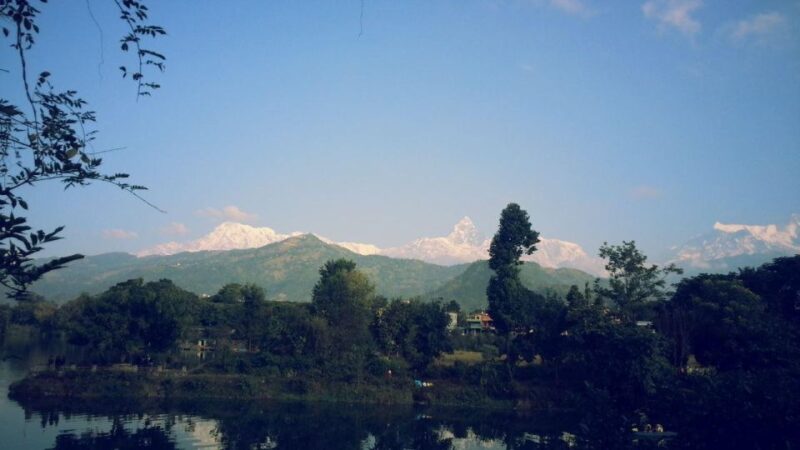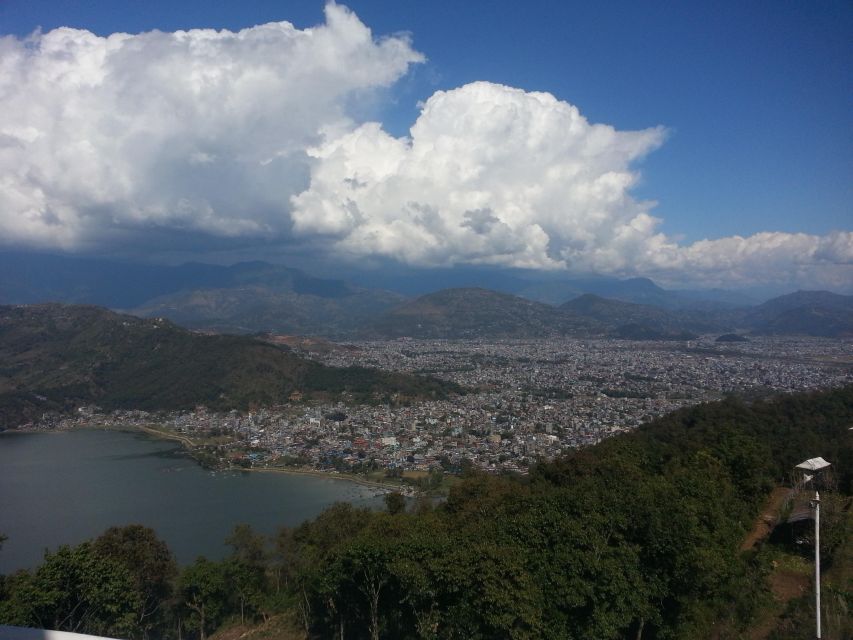Pokhara, the jewel of Nepal, offers a captivating day trip that immerses visitors in its stunning natural beauty and rich cultural heritage. From the serene Phewa Lake to the majestic Annapurna range, this picturesque destination beckons travelers to explore its breathtaking landscapes. Beyond the natural wonders, the city’s historical and spiritual sites, such as the World Peace Pagoda and Tibetan Refugee Camp, provide a window into the diverse traditions that shape Pokhara’s vibrant character. With an expert guide by your side, discover why this enchanting city is a must-visit on any Nepal itinerary. The journey awaits those eager to unveil Pokhara’s enchanting secrets.
Key Points

- Explore Pokhara’s diverse natural landscapes, including Phewa Lake, Barahi Temple, waterfalls, and caves, offering immersive experiences into the city’s natural beauty.
- Discover Pokhara’s rich cultural heritage, from the World Peace Pagoda and Tibetan Refugee Camp to the International Mountain Museum and local bazaar.
- Experience the spiritual significance of Pokhara, visiting sites like Bindbasini Temple and Jangchub Monastery, blending architecture and religious practices.
- Enjoy a comprehensive day tour with a private English-speaking guide, transportation, lunch, and entrance fees covered.
- Book a day trip to Pokhara for a duration of one day, with free cancellation up to 24 hours in advance.
Pokhara’s Breathtaking Landscapes

Nestled in the Seti Gandaki valley, Pokhara’s breathtaking landscapes offer visitors a captivating blend of natural wonders, from the serene waters of Phewa Lake to the majestic peaks of the Annapurna range towering in the distance.
The city’s elevation, ranging from 1000 to 7500 meters within just 30 kilometers, creates a diverse array of microclimates and environments. Visitors can marvel at the contrast of lush, verdant valleys and snow-capped mountain peaks, all within easy reach.
Pokhara’s unique position, combined with its high rainfall and mild temperatures, makes it a prime destination for nature enthusiasts seeking to enjoy Nepal’s stunning natural beauty.
Here are more great tours and experiences we've reviewed in Pokhara
Exploring Phewa Lake and Barahi Temple
A visit to Pokhara’s Phewa Lake and Barahi Temple offers travelers a chance to enjoy the city’s natural splendor and cultural heritage. Nestled on a small island in the tranquil waters of Phewa Lake, the Barahi Temple stands as a revered site for Hindu devotees, its striking pagoda-style architecture reflecting the region’s historical influences. Visitors can access the temple by boat, taking in the serene surroundings and the snow-capped Annapurna range that provides a majestic backdrop.
| Feature | Description |
|---|---|
| Phewa Lake | The second-largest lake in Nepal, known for its serene beauty |
| Barahi Temple | A pagoda-style Hindu temple on an island in Phewa Lake |
| Annapurna Range | The impressive snow-capped peaks that provide a stunning backdrop |
| Boating | The opportunity to access the temple by boat, enjoying the peaceful lake |
Cascading Waterfalls and Sacred Caves
Beyond the serenity of Phewa Lake, Pokhara’s natural wonders beckon visitors to explore its cascading waterfalls and sacred caves, offering a glimpse into the region’s geological marvels.
The tour takes you to the thundering David Falls, where the Seti Gandaki River plunges 70 meters into a deep gorge. Nearby, the Gupteshor Mahadev Cave is a revered Hindu pilgrimage site, its passages winding through towering limestone formations.
The Bat Cave, on the other hand, is home to thousands of these winged creatures, their chirping echoing through the darkness.
These sites not only showcase Pokhara’s natural beauty but also reflect the deep-rooted spiritual beliefs of the local people, making the day trip a truly immersive experience.
World Peace Pagoda and Tibetan Culture
The World Peace Pagoda, a gleaming white Buddhist stupa, stands atop a hill overlooking the serene Phewa Lake, offering visitors a panoramic view of Pokhara’s stunning landscapes and the majestic Annapurna range. This sacred site was built in 1985 as a symbol of world peace and harmony.
Nearby is the Tibetan Refugee Camp, home to a vibrant Tibetan community that has settled in Pokhara after fleeing Chinese occupation. Visitors can explore the camp’s handicraft shops, monasteries, and restaurants, seeing the rich Tibetan culture.
The International Mountain Museum is another must-visit attraction, showcasing the history, geography, and culture of the Himalayas through interactive exhibits and displays.
More Great Thing To Do NearbyImmersive Museum and Historical Experiences
Complementing the serene natural beauty of Pokhara, the city’s museums and historical sites offer visitors immersive experiences that showcase the region’s rich cultural heritage and captivating narratives.
At the International Mountain Museum, travelers can explore the history and significance of the world’s highest peaks, while the Gorkha Memorial Museum pays tribute to Nepal’s brave Gurkha soldiers.
The Tibetan Refugee Camp provides a unique opportunity to learn about the Tibetan diaspora and their vibrant traditions.
Plus, the Jangchub Monastery, with its intricate architecture and sacred Buddhist artifacts, invites visitors to connect with the spiritual essence of the Himalayas.
These engaging cultural and historical attractions complement the natural wonders, creating a well-rounded Pokhara experience.
Seti River Gorge and Local Bazaar
Pokhara’s Seti River Gorge offers visitors a captivating natural wonder, with its towering rock formations and cascading waterfalls carving a dramatic passage through the landscape.
Nearby, the lively Old Pokhara Bazaar provides a window into the city’s vibrant local culture, where shoppers can peruse a diverse array of handicrafts, textiles, and traditional Nepali wares.
From intricate wood carvings and vibrant textiles to fragrant spices and handmade pottery, the bazaar is a hub of activity and a favorite among both locals and travelers.
Visitors can enjoy the sights, sounds, and aromas of this bustling marketplace, bargaining with vendors and discovering unique souvenirs to bring home from their Pokhara adventure.
Spiritual Spaces and Architectural Marvels
Amidst the natural splendor of Pokhara’s landscapes, visitors uncover a tapestry of spiritual spaces and architectural marvels that captivate the senses and enlighten the mind.
The towering World Peace Pagoda, with its gleaming white dome and panoramic views, stands as a symbol of harmony and meditation.
The intricate Bindbasini Temple, dedicated to the goddess Durga, draws devotees seeking blessings.
The Jangchub Monastery, with its vibrant murals and chanting monks, offers a glimpse into Tibetan Buddhist culture.
The International Mountain Museum chronicles the region’s rich mountaineering heritage through interactive exhibits.
These diverse sites blend the sacred and the secular, inviting travelers to enjoy Pokhara’s unique blend of natural and cultural wonders.
Tour Inclusions and Booking Details
What does the Pokhara day trip include? The tour package covers the cost of a private English-speaking guide and vehicle, drinking water, and all entrance fees to the featured sites. Lunch is also provided as part of the day’s activities.
The trip can be booked with free cancellation up to 24 hours in advance, and the price starts at €55.70 per person. The tour is not suitable for wheelchair users, but participants can select their preferred date and check availability. To provide more details, here’s a breakdown of the tour inclusions and booking details:
| Inclusions | Booking Details |
|---|---|
| – Private English-speaking guide and vehicle | – Duration: 1 day |
| – Drinking water | – Price: From €55.70 per person |
| – Entrance fees to all sites | – Free cancellation up to 24 hours in advance |
| – Lunch | – Live English-speaking tour guide provided |
Frequently Asked Questions
What Is the Best Time of Year to Visit Pokhara?
The best time to visit Pokhara is during the dry season from October to May when the weather’s mild, skies are clear, and the Himalayas are visible. Avoid the monsoon season from June to September for the most comfortable experience.
Can I Customize the Itinerary for the Day Tour?
Yes, travelers can customize the itinerary for the day tour. Most tour providers offer flexibility to adjust the itinerary based on personal interests and time availability, allowing visitors to tailor the experience to their preferences.
Are There Any Restrictions for Photography During the Tour?
The tour generally allows photography at all the sites, but visitors should be respectful and avoid disrupting activities. Some locations may have limited photography restrictions, which the guide will inform participants about during the tour.
How Accessible Is the Tour for Elderly or Disabled Travelers?
The tour may not be fully accessible for elderly or disabled travelers. While some sites can be visited, the terrain and lack of accommodations could present challenges. Participants with mobility concerns should discuss their needs with the tour provider prior to booking.
What Is the Maximum Group Size for the Private Tour?
The private tour has a maximum group size of just the traveler and their party. It’s a fully private experience with a dedicated vehicle and English-speaking guide, allowing for personalized attention and flexibility during the day’s activities.
Recap
Pokhara’s day trip offers a captivating blend of natural splendor, culture, and historical insights.
From the serene Phewa Lake to the majestic Annapurna range, visitors can indulge in the region’s breathtaking landscapes.
The tour also includes visits to iconic landmarks like the World Peace Pagoda and the Tibetan Refugee Camp, providing a deep dive into the area’s rich heritage and traditions.
This well-rounded experience is a must-visit for those seeking to explore the beauty and diversity of Pokhara.
You can check if your dates are available here:More 1-Day Tours in Pokhara
More Tour Reviews in Pokhara
Not for you? Here's more things to do in Pokhara we have recnetly reviewed
- 2 Best Dining Experiences In Pokhara
- 20 Best 2 Day Tours In Pokhara
- 2 Best Dinner Tours In Pokhara
- 20 Best 3 Day Tours In Pokhara
- 20 Best 4 Day Tours In Pokhara
- 8 Best Cruises And Boat Tours In Pokhara
- 20 Best Full-Day Tours In Pokhara
- 16 Best Helicopter Flights And Tours In Pokhara
- Best 4 Day Tours In Naya Pul
- 7 Best Massage And Relaxation Services In Pokhara
- 6 Best Photography Experiences In Pokhara
- Ghorepani Poonhill Trek
